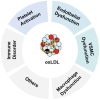Mechanisms of Oxidized LDL-Mediated Endothelial Dysfunction and Its Consequences for the Development of Atherosclerosis
- PMID: 35722128
- PMCID: PMC9199460
- DOI: 10.3389/fcvm.2022.925923
Mechanisms of Oxidized LDL-Mediated Endothelial Dysfunction and Its Consequences for the Development of Atherosclerosis
Abstract
Atherosclerosis is an immuno-metabolic disease involving chronic inflammation, oxidative stress, epigenetics, and metabolic dysfunction. There is compelling evidence suggesting numerous modifications including the change of the size, density, and biochemical properties in the low-density lipoprotein (LDL) within the vascular wall. These modifications of LDL, in addition to LDL transcytosis and retention, contribute to the initiation, development and clinical consequences of atherosclerosis. Among different atherogenic modifications of LDL, oxidation represents a primary modification. A series of pathophysiological changes caused by oxidized LDL (oxLDL) enhance the formation of foam cells and atherosclerotic plaques. OxLDL also promotes the development of fatty streaks and atherogenesis through induction of endothelial dysfunction, formation of foam cells, monocyte chemotaxis, proliferation and migration of SMCs, and platelet activation, which culminate in plaque instability and ultimately rupture. This article provides a concise review of the formation of oxLDL, enzymes mediating LDL oxidation, and the receptors and pro-atherogenic signaling pathways of oxLDL in vascular cells. The review also explores how oxLDL functions in different stages of endothelial dysfunction and atherosclerosis. Future targeted pathways and therapies aiming at reducing LDL oxidation and/or lowering oxLDL levels and oxLDL-mediated pro-inflammatory responses are also discussed.
Keywords: atherosclerosis; endothelial dysfunction; inflammation; oxidation; oxidized LDL.
Copyright © 2022 Jiang, Zhou, Nabavi, Sahebkar, Little, Xu, Weng and Ge.
Conflict of interest statement
SN is employed by Advanced Medical Pharma (BIOTEC), Benevento, Italy. The remaining authors declare that the research was conducted in the absence of any commercial or financial relationships that could be construed as a potential conflict of interest.
Figures
Similar articles
-
The Scavenger Receptor CD68 Regulates Platelet Mediated Oxidized Low-Density Lipoprotein (oxLDL) Deposition in Atherosclerotic Vessels at an Early Stage of Atherosclerosis in LDLR-/-/ApoBec-/- Mice.Cell Physiol Biochem. 2019;52(4):681-695. doi: 10.33594/000000048. Cell Physiol Biochem. 2019. PMID: 30921507
-
Overview of OxLDL and Its Impact on Cardiovascular Health: Focus on Atherosclerosis.Front Pharmacol. 2021 Jan 11;11:613780. doi: 10.3389/fphar.2020.613780. eCollection 2020. Front Pharmacol. 2021. PMID: 33510639 Free PMC article. Review.
-
Antibodies to oxidized low density lipoprotein: epidemiological studies and potential clinical applications in cardiovascular disease.Minerva Cardioangiol. 2007 Dec;55(6):821-37. Minerva Cardioangiol. 2007. PMID: 18091649 Review.
-
α5β1 integrin signaling mediates oxidized low-density lipoprotein-induced inflammation and early atherosclerosis.Arterioscler Thromb Vasc Biol. 2014 Jul;34(7):1362-73. doi: 10.1161/ATVBAHA.114.303863. Epub 2014 May 15. Arterioscler Thromb Vasc Biol. 2014. PMID: 24833794 Free PMC article.
-
Physiology and pathophysiology of oxLDL uptake by vascular wall cells in atherosclerosis.Vascul Pharmacol. 2016 Sep;84:1-7. doi: 10.1016/j.vph.2016.05.013. Epub 2016 May 30. Vascul Pharmacol. 2016. PMID: 27256928 Review.
Cited by
-
Mechanisms of inflammatory microenvironment formation in cardiometabolic diseases: molecular and cellular perspectives.Front Cardiovasc Med. 2025 Jan 14;11:1529903. doi: 10.3389/fcvm.2024.1529903. eCollection 2024. Front Cardiovasc Med. 2025. PMID: 39877020 Free PMC article. Review.
-
Immunotherapy and vaccine-based approaches for atherosclerosis prevention: a systematic review study.BMC Cardiovasc Disord. 2025 Mar 20;25(1):201. doi: 10.1186/s12872-025-04634-7. BMC Cardiovasc Disord. 2025. PMID: 40114074 Free PMC article.
-
The Effects of Statin Therapy on Oxidized LDL and Its Antibodies: A Systematic Review and Meta-Analysis.Oxid Med Cell Longev. 2022 Aug 1;2022:7850659. doi: 10.1155/2022/7850659. eCollection 2022. Oxid Med Cell Longev. 2022. Retraction in: Oxid Med Cell Longev. 2024 Jan 9;2024:9849024. doi: 10.1155/2024/9849024. PMID: 35958018 Free PMC article. Retracted.
-
Reduced antioxidant high-density lipoprotein function in heart failure with preserved ejection fraction.Clin Res Cardiol. 2025 Jan 15:10.1007/s00392-024-02583-3. doi: 10.1007/s00392-024-02583-3. Online ahead of print. Clin Res Cardiol. 2025. PMID: 39812805 Free PMC article.
-
Association between serum gamma-glutamyltransferase and early-onset coronary artery disease: a retrospective case-control study.Ann Med. 2023;55(2):2289606. doi: 10.1080/07853890.2023.2289606. Epub 2023 Dec 7. Ann Med. 2023. PMID: 38061693 Free PMC article.
References
Publication types
LinkOut - more resources
Full Text Sources





